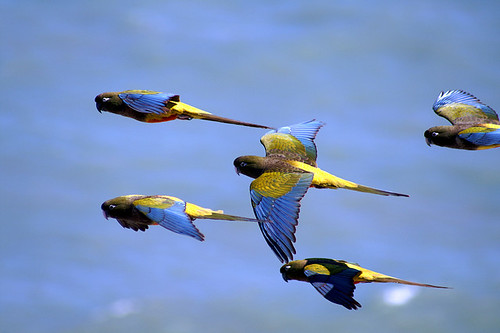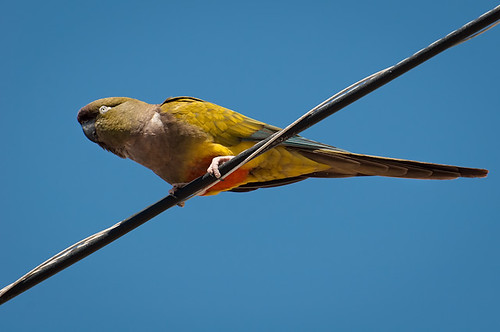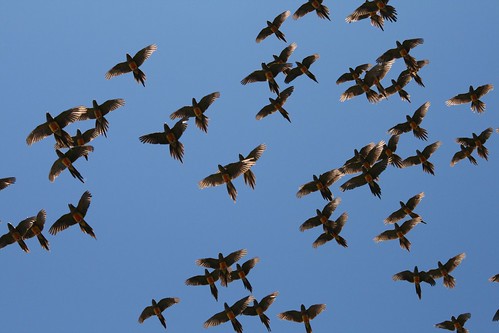 Burrowing Parrots, family in flight. Image by Erik SchepersYou might think that 180,000 squawking, screeching parrots living in 35,000 nests along 12km (seven miles) of coastline would draw quite a lot of attention.
Burrowing Parrots, family in flight. Image by Erik SchepersYou might think that 180,000 squawking, screeching parrots living in 35,000 nests along 12km (seven miles) of coastline would draw quite a lot of attention.
They make a lot of noise and, with their green backs and red and yellow bellies, are a spectacular sight as they swoop and circle above the cliffs looking out over the Atlantic Ocean.
British naturalist Charles Darwin found and wrote about them on his travels in the 1830s.
But not many Argentines are aware of the burrowing parrots (Cyanoliseus patagonus) which form the world's biggest parrot colony.
Admittedly, the birds are a long way from major centres of population - about 30km from the town of Viedma on the north-eastern tip of the region of Patagonia.
One Argentine who is not only aware of but facinated by the parrots is biologist Juan Masello. He returns every year from his home in Germany to track and chart their progress.
The birds, which can live for more than 20 years, are monogamous. Each year, after migration to warmer climates, they somehow return to the same nest, in the same hole carved among 35,000 other similar holes, some up to 3m deep, in the sandstone cliffs.
Tourism threat
 Burrowing Parrot at Puerto Madryn. Cláudio Dias TimmIt is a species that guards its secrets. The whole colony disappears for several days shortly before their annual autumn migration. And, despite intense observation, no one knows where they go.
Burrowing Parrot at Puerto Madryn. Cláudio Dias TimmIt is a species that guards its secrets. The whole colony disappears for several days shortly before their annual autumn migration. And, despite intense observation, no one knows where they go.
Mr Masello is hoping that technological advances will allow the birds to be tracked more precisely.
He and other environmentalists say the burrowing parrots, like many other parrot species, face a number of different threats.
Despite new legislation designed to tackle the trade in exotic species, the parrots are captured for the lucrative pet trade.
A booming tourist industry has seen holiday homes being built closer and closer to the colony. Irresponsible visitors forge tracks through the sandstone rocks where the parrots nest.
There is also an array of loud bikes and buggies being driven along the beach - traffic that disturbs the young birds. And paragliders now fly off the cliffs where only the parrots once flew.
Mr Masello says that many of these problems can be resolved with education, debate and compromise. But he says the biggest threat facing the burrowing parrots is the advance of agriculture.
Exasperated farmers
 Flock the sky, looking like sea birds these parrots are very unusual in their behaviour. Images by Brent BarrettArgentina's agriculture has boomed in recent years with beef, grains and soya fetching high prices on world markets.
Flock the sky, looking like sea birds these parrots are very unusual in their behaviour. Images by Brent BarrettArgentina's agriculture has boomed in recent years with beef, grains and soya fetching high prices on world markets.
Argentina's agricultural heartland is the Pampas - the lush, green pastures in the centre of the country.
But recent high prices have tempted farmers to cultivate land further afield, on what they call marginal land where the soil is poor. In the region around the parrot colony, they have scraped away the only vegetation of hardy thorned shrubs.
A few years of intensive farming drains the nutrition from the already poor soil and creates a desert.
"The vegetation is being removed at a rate of 3.7% a year," said Mr Masello.
"That is huge…four times higher than the Amazon."
The farmers blame the parrots, which they deem a pest, for the deterioration.
They accuse the feathered fiends of stealing their seeds and ruining their crops. Mr Masello admits that the parrots do take some seeds, but says the damage is minimal and insignificant.
"Some farmers are exasperated," said local farm leader Pedro Eddy.
"They've told me they'd like to fumigate the nests, exterminate them. But I don't think that's quite right. The parrots are only a problem because the farming is marginal. Tourism, attracted by this tremendous spectacle, could bring in more money than grain brings to the region," he said.
Noisy nuisance?
Many environmentalists say the farmers shouldn't even be there in the first place.
Either way, the parrots, which eat seeds, grasses and fruits, are finding their feeding grounds to be shrinking.
Mauricio Failla, the local representative of the Argentine Wildlife Foundation, says the answer lies in education.
He said that a few years ago, most local people viewed the parrots as a noisy nuisance. But with an extensive programme of visits to local schools and field trips to the parrot colony on the beach, opinions are changing.
The local provincial authority is looking at a new law to declare the colony a protected area. But the scheme has so far fallen foul of political infighting and bureaucracy.
Local representative Adriana Gutierrez told BBC News that the law would be in place soon. But Argentines have learned to be wary of politicians' promises.
Dawn comes early this far south, and the parrots make themselves heard before most people would like to be stirring from their sleep.
But after a few hours on the cliffs with thousands of swooping, screeching burrowing parrots, it was difficult not to be captivated by their beauty and curiosity.
Even if, several hours after leaving the region, their squawking was still ringing in my ears.